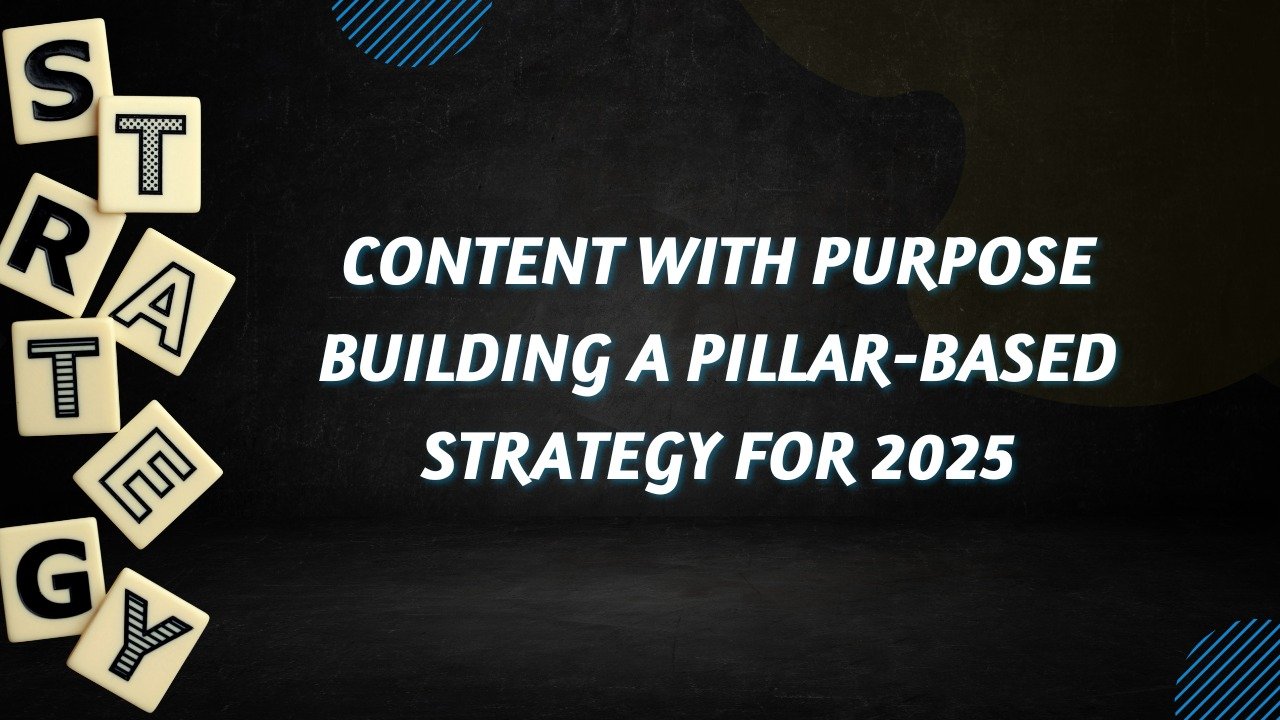Content with Purpose: Building a Pillar-Based Strategy for 2025

Let’s play a game. Take a quick look at your company’s blog or social media feed. What do you see?
A collection of random posts? A blog about an industry event from six months ago next to a infographic about a trending topic from last week? If this sounds familiar, you’re not alone. Many businesses treat content marketing services like a checklist—blog post: ✅, social update: ✅—without a unifying thread.
This “random acts of content” approach is exhausting. It drains resources, confuses your audience, and most importantly, it fails to build lasting authority.
But what if there was a better way? A strategic approach that transforms your content from a scattered noise into a powerful, interconnected library that both your audience and Google will love?
This is the power of a pillar-based strategy. As we look towards 2025, this methodology isn’t just a “nice-to-have”; it’s the cornerstone of effective content marketing services. It’s how you create content with a clear, undeniable purpose.
The Content Treadmill: Why What You’re Doing Isn’t Working
For years, the common advice was to “create more content.” So, that’s what everyone did. The result? A digital landscape flooded with generic, surface-level articles that all sound the same.
The old approach has three major flaws:
- It Lacks Focus: You jump from topic to topic, never fully owning any of them.
- It Hurts SEO: You create pages that compete with each other for search rankings, cannibalising your own potential.
- It Fails to Build Authority: A few scattered blog posts on a topic don’t make you an expert. A comprehensive, interlinked library does.
A pillar-based strategy is the antidote. It’s the shift from being a jack-of-all-trades to becoming the undisputed master of your core subjects.
What is a Pillar-Based Strategy? (The “Hub and Spoke” Model)
Imagine your website as a library. The old way is to have a bunch of unrelated pamphlets scattered on a table. The pillar-based way is to have organised bookshelves.
- The Pillar Page (The Bookshelf): This is a comprehensive, cornerstone piece of content that provides a 360-degree overview of a core topic. It’s typically a long-form page or guide that is optimised for a broad, “pillar” keyword. For example, “The Complete Guide to Content Marketing Services.”
- The Cluster Content (The Books): These are individual, more specific blog posts or articles that delve into the subtopics related to your pillar. They target long-tail keywords. For example, “What is a Content Pillar Strategy?”, “How to Measure Content Marketing ROI,” and “B2B vs. B2C Content Marketing.”
- The Hyperlinks (The Dewey Decimal System): This is the magic. You create a web of internal links that connect every cluster article back to the main pillar page, and from the pillar page out to each cluster. This creates a silo of information that is incredibly easy for users and search engines to navigate.
This structure signals to Google that your pillar page is the ultimate resource on that topic, boosting its authority and search rankings. For your user, it provides a seamless, educational journey that answers all their questions.
Why a Pillar Strategy is Your 2025 Competitive Advantage
Adopting this approach does more than just improve your SEO. It revolutionises your entire marketing engine.
1. It Establishes Unshakeable Authority
When a potential customer finds one of your cluster articles and then sees it’s part of a vast, interconnected resource, their trust in your brand skyrockets. You’re no longer just a vendor; you’re the educational resource in your space.
2. It Aligns Perfectly with How People Search
User search behaviour has evolved. People don’t just type in one keyword; they ask questions, seek tutorials, and compare solutions. Your cluster content captures this “exploration” phase of the buyer’s journey, while your pillar page serves as the final, definitive destination.
3. It Creates a Scalable, Efficient System
Instead of staring at a blank screen wondering what to write about next, your content calendar is built-in. Once you define your pillars, you have a clear roadmap of cluster topics to create. This makes your content marketing services infinitely more efficient and scalable. A study by the Content Marketing Institute (external link) confirms that organisations using this model see significant improvements in efficiency and results.
4. It Drives Organic Growth for the Long Term
A single, well-optimised pillar page supported by a network of cluster content can attract qualified traffic for years. It’s an asset that compounds in value, unlike a one-off post about a fleeting trend.
Your 4-Step Blueprint to Building Content Pillars in 2025
Ready to build your strategy? Here’s how to get started.
Step 1: Identify Your Core Pillars
What are the 3-5 broad, foundational topics that your business owns? These should be closely aligned with your products/services and address your customers’ biggest pain points.
- Example: A web design agency might have pillars like: “Web Development,” “User Experience (UX) Design,” and “Conversion Rate Optimisation.”
Step 2: Conduct Deep Keyword & Topic Research
For each pillar, brainstorm all the questions, subtopics, and related terms your audience searches for. Use tools like Ahrefs, SEMrush, or AnswerThePublic to find these “cluster” ideas.
- Example: For the “Web Development” pillar, clusters could be: “What is responsive design?”, “WordPress vs. Custom Development,” “Website Loading Speed Tips.”
Step 3: Create and Interlink Your Assets
- Build the Pillar Page: Create a substantial, link-worthy resource. It should be the best page on the internet for that core topic.
- Write the Cluster Content: Create detailed blog posts for each subtopic.
- Interlink Relentlessly: From every cluster article, link back to the main pillar page using relevant anchor text. From the pillar page, link out to the relevant cluster articles.
Step 4: Maintain and Update
A pillar-based strategy is a living system. Google rewards fresh, updated content. Regularly revisit your pillar pages and cluster articles to add new information, refresh statistics, and ensure all links are working. This is a key part of professional content marketing services.
The Future of Content is Structured
As we move into 2025, the brands that will win are the ones that provide clarity in a world of noise. A pillar-based strategy is the framework for doing just that. It forces you to think deeply about your audience’s needs and to serve them with purpose-driven, organised content.
This isn’t just another marketing tactic; it’s a fundamental shift in how you view your content—from a cost centre to a strategic, appreciating asset.
If the idea of building a powerful, purpose-driven content library excites you but the execution feels daunting, our expert content marketing services are designed specifically for this. We help you define your pillars, build your clusters, and create a system for sustainable growth.



